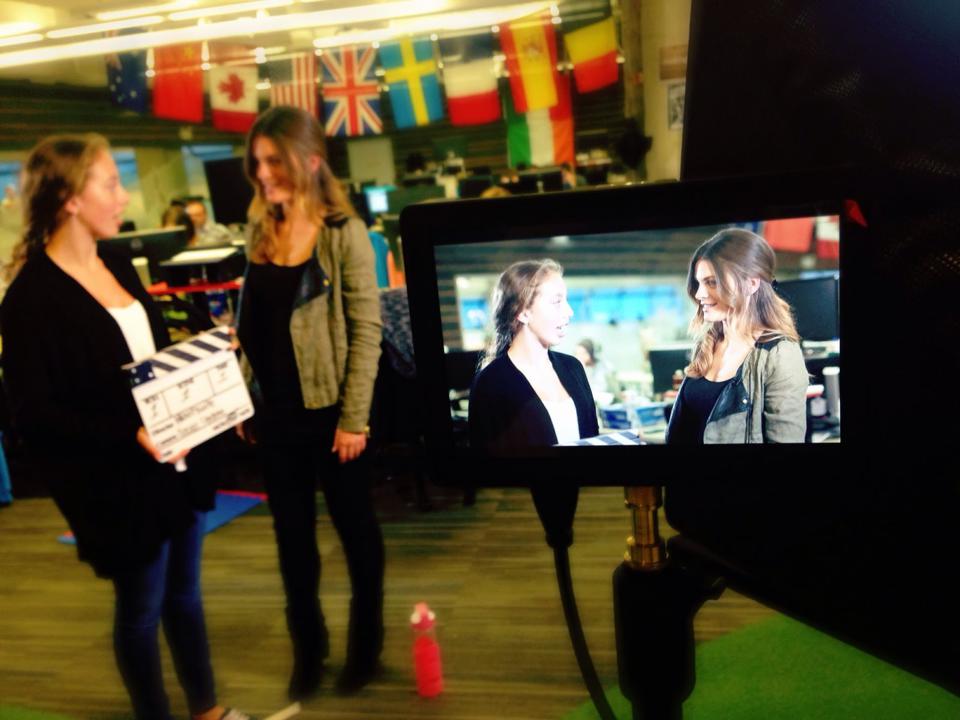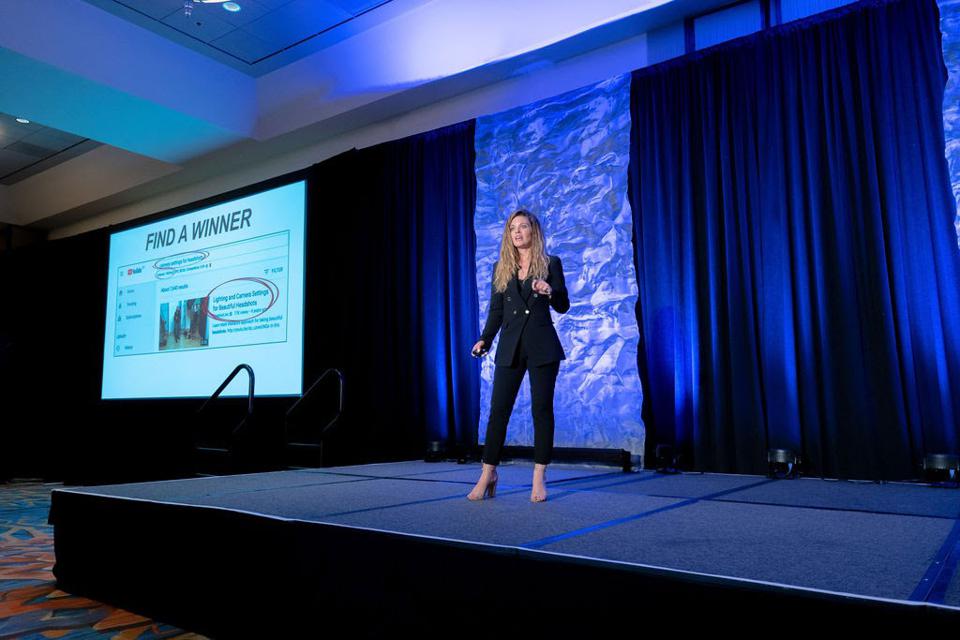With videos that have been viewed more than 27 million times, Sunny Lenarduzzi is by all accounts a YouTube success story. But the social media consultant and course creator whose company brought in eight figures over the past four years admits that her very first YouTube video was an epic failure.
“It took eight hours to record, the lighting was awful and I burst into tears after I was done for the day,” says Sunny, a former TV reporter who covered social media. “I had been used to filming on multimillion dollar sets and broadcasting to big audiences. But at that point, I was shooting in my parents’ basement and wondering if anyone would even care about what I was talking about. I recorded five videos and then I gave up—right before I was about to make a video that changed everything.”
Yes, that’s right. This YouTube sensation-to-be temporarily called it quits. Her mistake? Setting expectations far too high and putting way too much pressure on herself. It’s just one of several experiences that helped her develop a multimillion dollar mantra that has led to her success: “Test, fail, learn, grow, repeat.” The mantra is an important reminder that in the world of entrepreneurship, mistakes aren’t just inevitable, they’re essential for growth.
I caught up with Sunny to discuss the three remaining mistakes that led to her rapid business growth and what everyone needs to know about achieving six-figure success with an online course this year.
Stephanie Burns: How did you get started in your career?
Sunny Lenarduzzi: In my first job, I was working at a radio station making $26,500 a year—and I was ecstatic about it. I have always had a knack for storytelling and I felt like I was following in the journalistic footsteps of my icon, Oprah. I transitioned to television, reporting on everything from local heroes to sports, but after a few years, I got frustrated by the lack of creative freedom and control over my schedule.
I decided to start an online magazine for men as a side hustle and spent countless hours working on the content, the images and online promotion. But after three months, I only made a whopping $500 off of it thanks to ad revenue. I had been doing “all the things” except for focusing on the actions that bring in money and that was a big mistake. As an entrepreneur, every day you have to be thinking about revenue generating activities. Even though the online magazine wasn’t a success, it allowed me to build an audience on social media and attract the attention of clients who wanted me to manage their social media strategy and outreach. But working multiple jobs was completely exhausting and unsustainable.
Burns: When did you know it was time to leave television?
Lenarduzzi: My station manager offered me a promotion that should’ve been my dream job, but it wasn’t. After six months of that brutal schedule, it was television—not my business—that I wanted to give up on. So I quit working for the station and put all my energy into being my own boss. At that point, I had a steady roster of clients and years of experience working with big corporations and personal brands in growing their revenue through social media.

GEORGIA STREET MEDIA
Burns: How did you know it was time to go back to YouTube after quitting it?
Lenarduzzi: It was a happy accident. My clients kept asking me questions about their social media accounts and I got tired of giving everyone the same responses over and over again. So I decided to make just a few more videos. Periscope had just debuted and I was getting a lot of questions about it, so I made a tutorial explaining how to use the platform. It started to get a lot of views, so I wondered, “What if I just answered social media questions in my YouTube videos?” My channel took off—and it didn’t matter that I was barely wearing any makeup and wearing a t-shirt with halfway decent lighting. Great content on YouTube has nothing to do with aesthetic perfection, and everything to do with relevancy to the right viewer. What’s more, valuable content will continue to work for you even when you’re not working.
Burns: What would you say is the biggest mistake that you’ve made in your entrepreneurial career?
Lenarduzzi: There were actually two big mistakes that I paid the same price for by falling victim to burnout and ending up having the paramedics take me to the hospital. The first mistake was having multiple business models running all at the same time. After the videos took off, momentum was building around my business. But I couldn’t handle it all because I was my business. It was basically just me. I was still doing one-on-one work managing individual accounts and had launched my signature course, YouTube for Bosses, but a nagging voice in my head said, “You’re not busy enough.” So I added on agency work and I also started taking on sponsorship opportunities, because I was constantly being pitched now that I had an audience.
I had this idea in my head that running a business couldn’t be easy. It had to be difficult and that I should be working myself into the grave if I wanted to be successful. I didn’t realize that you have to have “Bow and Arrow” phases in your business where you pull back to rest and recover so you can launch forward and go hard. I was constantly launching forward and pushing myself in so many different directions. I was trying to prove my worth by being busy. However, being busy doesn’t equate to more success or more anything. In fact, it was a massive waste of time and energy which led to my second big mistake: burning out. When you’re trying to be perfect, you’re eventually going to collapse.
Burns: How did you end up in the hospital from burnout?
Lenarduzzi: I was actually on a two-week vacation when it happened. I had spent the day at the beach and I was relaxing at home trying to fall asleep when my heart started racing and the walls felt like they were closing in on me. I turned on my computer and googled, “What to do during a panic attack.” The results didn’t help. I ended up having the paramedics, who thought I was having a stroke, come to my apartment to take me to the hospital. It turned out that it was, in fact, a panic attack. I was embarrassed and ashamed. Most of all, the experience terrified me into making some real changes in my life.
Burns: What changes did you make after you got out of the hospital?
Lenarduzzi: I started focusing on building a business that worked for me and not against me. That meant doing something I call “subtracting your way to success.” I fired clients, shut down parts of my business and turned myself into the queen of saying “No.” Ironically, saying “No” so often led to exponential growth. I doubled my income that year—and every year since. Saying “No” frees up time to build relationships with clients and focus on business moves that lead to the outcome you’re trying to achieve. I figured out how to do less, but earn more and have a greater impact through my courses.

Burns: What are some secrets to creating a five- or six-figure or seven-figures course—especially without buying ads?
Lenarduzzi: One of my best tips is something I call the “50 ICA’s Technique.” Before my students can create their course, they do intensive market research into what their actual ideal client’s needs are—not what they think that person’s needs are. They have to do 50 phone calls with real people to collect this information and then design their course. It’s a lot of work, but the beauty of putting in that effort is that you’ve developed an audience. Once you’ve designed the perfect course for them, you can return to those 50 people as warm leads and ask them to become your first buyers.
Before my students start selling their course, I also have them come up with a powerful transformation statement. At the end of the day, transformation—not information—is going to be the key to getting attention on social media and creating a successful online course. Your potential clients are going to be sold on the change you’ll be able to create in their lives, not on how many lessons you have in each module. My transformation statement is: “I help experts go from unknown to the authority so they can elevate their impact, income and audience on autopilot.” It has helped me sell my courses to more than 8,000 students across the globe.
Burns: Why is helping students create successful courses so important to you?
Lenarduzzi: It goes back to the freedom that I was searching for that led me to leave my job in television. Generating income this way not only allows you freedom of time, but also freedom to invest in things that you care about. Generating eight figures over the course of four years has enabled me to empower other female entrepreneurs whose businesses need a hand so that they can become the CEOs of their lives. I’ve created a video series around random acts of generosity that I’ve been able to deliver to a single mom and a cancer survivor. When my students master my techniques, they’re able to give back in areas they care about. It’s not just about money, though. It’s also about what you’re able to teach people by sharing your story. Both those life-changing impacts can be your legacy.
Article Credit: forbes
